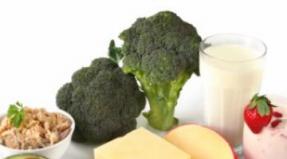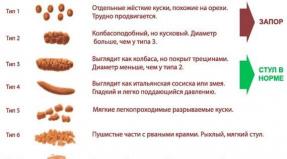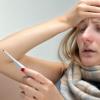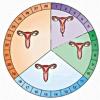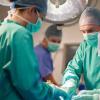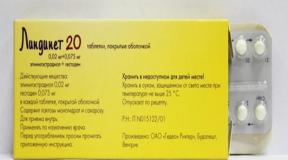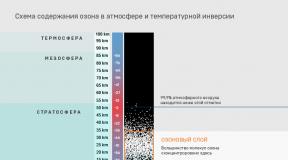The process of breathing in humans. Breathing How a person inhales and exhales
The act of breathing consists of rhythmically repeated inhalation and exhalation.
Inhalation is carried out as follows. Under the influence of nerve impulses, the muscles involved in the act of inhalation contract: the diaphragm, external intercostal muscles, etc. The diaphragm descends (flattens) during its contraction, which leads to an increase in the vertical size of the chest cavity. With the contraction of the external intercostal and some other muscles, the ribs rise, while the anteroposterior and transverse dimensions of the chest cavity increase. Thus, as a result of muscle contraction, the volume of the chest increases. Due to the fact that there is no air in the pleural cavity and the pressure in it is negative, simultaneously with an increase in the volume of the chest, the lungs also expand. When the lungs expand, the air pressure inside them decreases (it becomes lower than atmospheric pressure) and atmospheric air rushes through the respiratory tract into the lungs. Consequently, when inhaling, the following sequentially occurs: muscle contraction - an increase in the volume of the chest - the expansion of the lungs and a decrease in pressure inside the lungs - the flow of air through the airways into the lungs.
Exhalation follows inhalation. The muscles involved in the act of inhalation relax (the diaphragm rises at the same time), the ribs, as a result of contraction of the internal intercostal and other muscles, and due to their heaviness, fall. The volume of the chest decreases, the lungs contract, the pressure in them rises (becomes higher than atmospheric pressure), and air rushes out through the airways.
The mechanism of regulation of respiration is very complex. In a schematic presentation, it boils down to the following. In the medulla oblongata there is a cluster of nerve cells that regulate breathing - the respiratory center. The respiratory center is divided into two sections: the inhalation section and the exhalation section. The function of both sections is interconnected: when the inhalation section is excited, the exhalation section is inhibited and, conversely, the exhalation section is accompanied by inhibition of the inhalation section. In addition to the respiratory center, which is located in the medulla oblongata, special accumulations of nerve cells in the pons and in the diencephalon are involved in the regulation of respiration. The respiratory center exerts its influence on the respiratory muscles, on which the change in the volume of the chest during inhalation and exhalation depends, not directly, but through the spinal cord. In the spinal cord there are groups of cells whose processes (nerve fibers) go as part of the spinal nerves to the respiratory muscles. When the respiratory center (inspiration department) is excited, nerve impulses are transmitted to the spinal cord, and from there along the nerves to the respiratory muscles, causing their contraction; as a result, the chest expands and inhales. The cessation of the transmission of impulses from the respiratory center (during inhibition of the inhalation department) to the spinal cord, and from it to the respiratory muscles, is accompanied by relaxation of these muscles; as a result, the chest collapses and exhalation occurs.
In the respiratory center, there is an alternate change in the state of excitation and inhibition (inhalation and exhalation), which causes rhythmic alternations of inhalation and exhalation. Changes in the state of the respiratory center depend on nervous and humoral influences. In this case, an important role belongs to the receptors of the lungs and carbon dioxide in the blood. During inhalation, the lungs are stretched and due to this, the vagus nerve endings embedded in the lung tissue are irritated. Nerve impulses that have arisen in the receptors are transmitted along the vagus nerve to the respiratory center, causing excitation of the expiratory section and, at the same time, inhibition of the inhalation section. As a result, the transmission of impulses from the respiratory center to the spinal cord stops and exhalation occurs. When exhaling, the lung tissue collapses, the receptors of the lung are not irritated, nerve impulses from the receptors do not enter the respiratory center. As a result, the exhalation section comes into a state of inhibition, while the inhalation section is excited and inhalation occurs. Then everything repeats again. Thus, automatic self-regulation of breathing is carried out: inhalation causes exhalation, and exhalation causes inhalation.
Carbon dioxide is a specific causative agent of respiration. When carbon dioxide accumulates in the blood to a certain concentration, special receptors in the walls of blood vessels are irritated. The impulses that have arisen in the receptors are transmitted along the nerve fibers to the respiratory center (inspiration department) and cause its excitation, which is accompanied by a deepening and quickening of breathing. In addition, carbon dioxide also has a direct effect on the respiratory center: an increase in the concentration of carbon dioxide in the blood surrounding the respiratory center causes its excitation. A decrease in the concentration of carbon dioxide in the blood is accompanied, on the contrary, by a decrease in the excitability of the respiratory center (inspiration department).
If, as a result of intensive muscular work or for other reasons, an excessive amount of carbon dioxide accumulates in the blood, then due to the excitation of the respiratory center, breathing becomes rapid - shortness of breath occurs. As a result, carbon dioxide is quickly excreted from the body and its content in the blood becomes normal. Respiration rate also becomes normal. The accumulation of carbon dioxide automatically causes its rapid removal and thereby a decrease in the excitability of the respiratory center (inspiratory section).
Along with an excess of carbon dioxide, the excitation of the respiratory center is also caused by a lack of oxygen, as well as some other substances that have entered the blood, in particular, special medicinal substances. It should be noted that the reflex effect on the respiratory center is exerted not only by irritation of the receptors of the walls of blood vessels and the receptors of the lungs themselves, but also by other influences (for example, irritation of the nasal mucosa with ammonia, skin irritation with cold water, etc.).
Breathing is subordinated to the cerebral cortex, as evidenced by the fact that a person can voluntarily hold his breath (albeit for a very short time) or change its depth and frequency. Evidence of the cortical regulation of respiration is also an increase in respiration during emotional states.
Protective acts are associated with breathing: coughing and sneezing. They are carried out reflexively, and the centers of these reflexes are located in the medulla oblongata.
Cough occurs in response to irritation of the mucous membrane of the larynx, pharynx or bronchi (when particles of dust, food, etc. get there). When coughing after a deep breath, the air is forced out of the respiratory tract with force and sets the vocal cords in motion (a characteristic sound occurs). Together with the air, what irritated the respiratory tract is removed.
Sneezing occurs in response to irritation of the nasal mucosa in the same way as coughing.
Coughing and sneezing are protective respiratory reflexes.
Criteria for assessing the activity of the respiratory system.
Three types of breathing are determined: chest, abdominal (diaphragmatic) and mixed. With the chest type of breathing, the clavicles rise noticeably and the ribs move. With this type of breathing, the volume of the lungs increases mainly due to the movement of the upper and lower ribs. With the abdominal type of breathing, an increase in the volume of the lungs occurs mainly due to the movement of the diaphragm - on inspiration, it goes down, slightly shifting the abdominal organs. Therefore, the abdominal wall protrudes slightly during inhalation with the abdominal type of breathing. Athletes, as a rule, have a mixed type of breathing, where both mechanisms of increasing the volume of the chest are involved.
Percussion(tapping) allows you to determine the change (if any) in the density of the lungs. Changes in the lungs are usually the result of certain diseases (pneumonia, tuberculosis, etc.).
Auscultation(listening) determines the state of the airways (bronchi, alveoli). With various diseases of the respiratory organs, very characteristic sounds are heard - various wheezing, strengthening or weakening of respiratory noise, etc.
The study of external respiration is carried out according to indicators characterizing ventilation, gas exchange, content and partial pressure of oxygen and carbon dioxide in arterial blood and other parameters. To study the function of external respiration, spirometers, spirographs and special devices of open and closed type are used.
Respiratory parameters.
Residual air(OV) - the volume of air remaining in the lungs that did not return to their original position.
Breathing rate(BH) - the number of breaths in 1 min. The determination of the respiratory rate is made according to the spirogram or by the movement of the chest. The average respiratory rate in a healthy person is 16-18 per minute, in athletes - 8-12. Under conditions of maximum load, the frequency rate increases to 40-60 in 1 min.
Breathing depth(DO) - the volume of air of a calm inhalation or exhalation during one respiratory cycle. The depth of breathing depends on the height, weight, gender and functional state of the athlete. In healthy individuals, DO is 300-800 ml.
Minute breathing volume(MOD) characterizes the function of external respiration.
In a calm state, the air in the trachea, bronchi, bronchioles and non-perfused alveoli does not participate in gas exchange, since it does not come into contact with active pulmonary blood flow - this is the so-called "dead" space. The part of the respiratory volume that participates in gas exchange with the pulmonary blood is called the alveolar volume. From a physiological point of view, alveolar ventilation is the most essential part of external respiration, since it is the volume of air inhaled per minute that exchanges gases with the blood of the pulmonary capillaries.
MOD is measured by the product of BH by DO. In healthy individuals, the respiratory rate is 16-18 per minute, and the DO ranges from 350-750 ml, in athletes, the respiratory rate is 8-12 ml, and the DO is 900-1300 ml. An increase in MOD (hyperventilation) is observed due to excitation of the respiratory center, difficulty in oxygen diffusion, etc.
At rest, the MOD is 5-6 liters, with strenuous physical activity it can increase 20-25 times and reach 120-150 liters in 1 minute or more. The increase in MOD is directly dependent on the power of the work performed, but only up to a certain point, after which the increase in load is no longer accompanied by an increase in MOD.
Even with the heaviest load, the MOD never exceeds 70-80% of the maximum ventilation level. The calculation of the proper value of the MOD is based on the fact that in healthy individuals, approximately 40 ml of oxygen is absorbed from each liter of ventilated air (this is the so-called oxygen utilization factor).
ventilation equivalent(VE) is the ratio between the MOD and the amount of oxygen consumption. At rest, 1 liter of oxygen in the lungs is absorbed from 20-25 liters of air. With heavy physical exertion, the ventilation equivalent increases and reaches 30-35 liters. Under the influence of endurance training, the ventilatory equivalent at standard load decreases. This indicates more economical breathing in trained individuals.
Vital capacity of the lungs(VC) consists of tidal volume, inspiratory reserve volume, and expiratory reserve volume. VC depends on sex, age, body size and fitness. VC averages 2.5-4 liters in women, and 3.5-5 liters in men. Under the influence of training, VC increases, in well-trained athletes it reaches 8 liters.
Total lung capacity(RTL) is the sum of VC and residual lung volume, that is, the air that remains in the lungs after maximum expiration and can only be determined indirectly. In young healthy people, 75-80% of the TCL is occupied by VC, and the rest is accounted for by the residual volume. In athletes, the proportion of VC in the structure of the HL increases, which favorably affects the efficiency of ventilation.
Maximum ventilation of the lungs(MVL) is the maximum possible amount of air that can be ventilated through the lungs per unit time. Usually, forced breathing is carried out for 15 seconds and multiplied by 4. This will be the value of MVL. Large fluctuations in MVL reduce the diagnostic value of determining the absolute value of these values. Therefore, the obtained value of MVL lead to the proper one.
The volume of air remaining in the lungs after maximum exhalation(OO) most fully and accurately characterizes gas exchange in the lungs.
One of the main indicators of external respiration is gas exchange (analysis of respiratory gases - carbon dioxide and oxygen in the alveolar air), that is, the absorption of oxygen and the removal of carbon dioxide. Gas exchange characterizes external respiration at the stage "alveolar air - blood of pulmonary capillaries". It is studied by gas chromatography.
The functional test of Rosenthal allows you to judge the functionality of the respiratory muscles. The test is carried out on a spirometer, where VC is determined in the subject 4-5 times in a row with an interval of 10-15 seconds. Normally, they receive the same indicators. A decrease in VC throughout the study indicates fatigue of the respiratory muscles.
Pneumotonometric indicator(PTP, mmHg) makes it possible to assess the strength of the respiratory muscles, which is the basis of the ventilation process. PTP decreases with physical inactivity, with long breaks in training, with overwork, etc. The study is carried out with a pneumotonometer V.I. Dubrovsky and I.I. Deryabina (1972). The subject exhales (or inhales) into the mouthpiece of the apparatus. Normally, in healthy individuals, PTP averages 328 ± 17.4 mm Hg in men on expiration. Art., on inspiration - 227 ± 4.1 mm Hg. Art., in women, respectively, - 246 ± 1.8 and 200 ± 7.0 mm Hg. Art. With lung diseases, hypodynamia, overwork, these indicators decrease.
The Stange and Genchi tests give some idea of the body's ability to withstand the lack of oxygen.
Stange test. The maximum breath holding time after a deep breath is measured. In this case, the mouth should be closed and the nose pinched with fingers. Healthy people hold their breath for an average of 40-50 seconds; highly qualified athletes - up to 5 minutes, and athletes - from 1.5 to 2.5 minutes.
Genchi test. After a shallow breath, exhale and hold your breath. In healthy people, the breath holding time is 25-30 s. Athletes are able to hold their breath for 60-90 seconds. With chronic fatigue, the breath holding time decreases sharply.
Questions at the beginning of the paragraph.
Question 1. How is gas exchange maintained in the lungs?
Since carbon dioxide continuously flows from the blood into the alveolar air, and oxygen is absorbed by the blood and consumed, ventilation of the alveolar air is necessary to maintain the gas composition of the alveoli. It is achieved through respiratory movements: the alternation of inhalation and exhalation. The lungs themselves cannot pump or expel air from their alveoli. They only passively follow the change in the volume of the chest cavity. Since the pressure in the pleural cavity, the slit-like space between the lungs and the walls of the chest cavity, is less than the air pressure in the lungs, the lungs are always pressed against the walls of the chest cavity and accurately follow the change in its configuration. When inhaling and exhaling, the pulmonary pleura slides along the parietal pleura, repeating its shape.
Question 2. What causes inhalation and exhalation?
Inhalation consists in the fact that the diaphragm goes down, pushing the abdominal organs, and the intercostal muscles lift the chest up, forward and to the sides. The volume of the chest cavity increases, and the lungs follow this increase, since the gases contained in the lungs press them against the parietal pleura.
Exhalation begins with the fact that the intercostal muscles relax. Under the influence of gravity, the chest wall goes down, and the diaphragm rises up, because the stretched wall of the abdomen presses on the internal organs of the abdominal cavity, and they - on the diaphragm. The volume of the chest cavity decreases, the lungs are compressed, the air pressure in the alveoli becomes higher than atmospheric pressure, and part of it comes out. All this happens with calm breathing.
Question 3. How does the respiratory center work?
The respiratory center is located in the medulla oblongata. It consists of centers of inhalation and exhalation, which regulate the work of the respiratory muscles. The collapse of the pulmonary alveoli, which occurs during expiration, reflexively causes inspiration, and the expansion of the alveoli reflexively causes exhalation.
The work of the respiratory centers is also influenced by other centers, including those located in the cerebral cortex. Due to their influence, breathing changes when talking and singing. It is also possible to consciously change the rhythm of breathing during exercise.
Question 4. What happens during coughs and sneezes?
Irritation of the nasal mucosa by dust or an unpleasantly smelling substance causes a short-term cessation of breathing and closing of the glottis. Then begins an intense (forced) exhalation. The air pressure builds up, and there comes a moment when it breaks with force through the closed vocal cords. A jet of air is directed outward, and a characteristic sound of sneezing occurs. Together with air and mucus, mucosal irritants are also released.
When coughing, the same thing happens as when sneezing, only the main stream of air comes out through the mouth. The cause of coughing may be irritation of the mucous membrane of the lungs, bronchi, trachea, larynx, and pleura. Thus, sneezing and coughing are protective.
Question 5. How is the humoral regulation of respiration carried out?
During muscular work, oxidation processes are enhanced. Consequently, more carbon dioxide is released into the blood. When blood with an excess of carbon dioxide reaches the respiratory center and begins to irritate it, the activity of the center increases. The person begins to breathe deeply. As a result, excess carbon dioxide is removed, and the lack of oxygen is replenished. If the concentration of carbon dioxide in the blood decreases, the work of the respiratory center is inhibited and involuntary breath holding occurs. Thanks to nervous and humoral regulation, the concentration of carbon dioxide and oxygen in the blood is maintained at a certain level under any conditions.
Question 6. What is the harm of smoking?
Narcogenic substances, to which the nicotine contained in tobacco belongs, are included in the metabolism and interfere with the nervous and humoral regulation, violating both. In addition, substances in tobacco smoke irritate the mucous membrane of the respiratory tract, which leads to an increase in the mucus secreted by it. Therefore, smokers have a cough: the lungs are protected from the harmful effects of smoking.
Question 7. Is it important to know what we breathe?
It is very important to know what we breathe. Even in a very stuffy room, the oxygen content decreases slightly, but the carbon dioxide concentration rises rapidly. At the same time, not only he, but also tobacco smoke, and vodka fumes, and other harmful substances adversely affect the body. Therefore, staying in a stuffy room leads to headaches, lethargy, and decreased performance.
Where stove heating is used, carbon monoxide (CO) - carbon monoxide, which is extremely toxic - can be in the air. It easily forms a strong compound with blood hemoglobin - carboxyhemoglobin. Hemoglobin molecules that have captured carbon monoxide are permanently unable to carry oxygen from the lungs to the tissues. There is a lack of oxygen in the blood and tissues, which affects the functioning of the brain and other organs.
Questions at the end of the paragraph.
Question 1. Why is ventilation of the lungs possible only if the cavities in which the lungs are located are hermetically closed, and pressure below atmospheric pressure is maintained in the pleural cavity?
Due to the elasticity of the lungs, the hermetic closure of the pleural cavity and the presence of subatmospheric pressure in it, the lungs follow the moving walls of the chest and passively stretch. The air pressure in the alveoli of the lungs becomes less than atmospheric, which leads to the movement of air from the environment into the lungs - inhalation occurs. If there is a depressurization of the pleural cavity, the lungs lose their connection with the pleura and the ability to expand after the chest - they collapse.
Question 2 Why, when injured, when the wound reaches the pleural cavity, air rushes in with a whistle, the lung collapses and cannot function?
When injured, when the wound reaches the pleural cavity, the lung collapses, as the pressure in the pleural cavity compares with atmospheric pressure and the force holding the lung in a position pressed against the pleural cavity (and chest) disappears.
Question 3. Why can an intact lung work despite the fact that the second lung is disabled?
This is due to the fact that each lung is isolated from each other.
Question 4. Where is the respiratory center?
The respiratory center is located in the medulla oblongata.
Question 5. Why does inhalation replace exhalation?
The collapse of the pulmonary alveoli during exhalation reflexively causes inspiration, and the expansion of the alveoli reflexively causes exhalation. Humoral regulation of respiration is also carried out. The activity of the respiratory center increases with an increase in the concentration of carbon dioxide in the blood.
Question 6. What is the role of coughing and sneezing?
Sneezing and coughing are protective in nature, in which, together with air and mucus, irritants of the mucous membrane of the respiratory tract are released to the outside.
Question 7. How does the air in the room change with a large crowd of people and poor ventilation?
Under such conditions indoors there is a decrease in the oxygen content and a rapid increase in the concentration of carbon dioxide.
Question 8. What first aid measures should be taken in case of carbon monoxide or household gas poisoning?
In case of poisoning with carbon monoxide or household gas, the victim must be taken to fresh air and forced to breathe deeper. You can give him a sniff of ammonia, then drink tea. If you lose consciousness or stop breathing, give artificial respiration.
Question 9. When carbon monoxide is damaged, carboxyhemoglobin is formed in the blood. What are its properties and why is carbon monoxide so dangerous?
Carbon monoxide (CO) forms a fairly stable compound with hemoglobin - carboxyhemoglobin. As a result, hemoglobin molecules are occupied and cannot carry oxygen, which leads to oxygen starvation of tissues. Brain cells are especially sensitive to oxygen deficiency.
Prolonged exposure to carbon monoxide causes death.
Question 10. What is the harmful effect of dust?
Dust can mechanically injure the walls of the pulmonary vesicles, airways, cause allergies, and impede gas exchange. Microbes, viruses that cause infectious diseases settle on dust particles. Also, dust can cause chemical poisoning if it contains particles of lead, nickel, chromium.
Question 11. What are the sources of air pollution?
The main sources of pollution include motor vehicle emissions, industrial emissions of gases, harmful chemicals, the use of pesticides, mineral fertilizers in agriculture, etc.
“Daddy, what is breathing?” - I recently heard from my little son and, to be honest, I was a little confused. Despite the fact that this process is so familiar, it is difficult to take it like this and explain how it happens. I had to look for an answer to this question and explain to the “why” how a person inhales and exhales.
The process of inhalation and exhalation in humans
To begin with, it is necessary to clarify that in fact lungs are unable to contract on their own or stretch, which means they are passive. The process of breathing is due to the fact that the lungs change volume depending on the position of the chest. Of course, few people pay attention to how he breathes, and despite the fact that you can partially control breathing, in fact it is an independent process. A special part of the brain, the respiratory center, is responsible for this function of the body, which coordinates the work of:
- 11 pairs of external intercostal muscles;
- abdominal press;
- 12 pairs of muscles lifting the ribs;
- diaphragm.

How is inhalation
In this case, only when lowering the diaphragm the volume is already increasing to 900-1100 ml. At the same time, another group of muscles - intercostal, as if scrolling around the axis, which entails some expansion of the chest cavity. As already mentioned, the lungs, following the chest, are stretched, which means that they pressure drop occurs. In view of the resulting difference, atmospheric air tends to fill the space - inhalation occurs.
How is exhalation
At the end of inhalation, relaxation of muscle tissue, which leads to a contraction of the chest, which means that there is a reduction in volume. Hence, lungs also collapse and the air rushes out. In this process, a significant role is played by the abdominal muscles, which transmit pressure on the abdomen, and it transmits pressure to the diaphragm.

It is worth noting that men and women have slightly different breathing patterns. In men, breathing mainly occurs due to the abdominal muscles, while in women it is due to the intercostal muscles. The thing is that in women, the abdominal cavity is assigned important function - playback, which means that the active work of the muscles of this zone can harm the child.
Normal physiology: lecture notes Svetlana Sergeevna Firsova
3. Inspiratory and expiratory mechanism
3. Inspiratory and expiratory mechanism
In an adult, the respiratory rate is approximately 16–18 breaths per minute. It depends on the intensity of metabolic processes and the gas composition of the blood.
The respiratory cycle consists of three phases:
1) inspiratory phases (lasts approximately 0.9–4.7 s);
2) expiratory phases (lasting 1.2–6.0 s);
3) respiratory pause (non-constant component).
The type of breathing depends on the muscles, so they distinguish:
1) chest. It is carried out with the participation of the intercostal muscles and muscles of the 1-3rd respiratory gap, when inhaling, good ventilation of the upper section of the lungs is provided, typical for women and children under 10 years old;
2) abdominal. Inhalation occurs due to contractions of the diaphragm, leading to an increase in vertical size and, accordingly, better ventilation of the lower section, which is inherent in men;
3) mixed. It is observed with the uniform work of all respiratory muscles, accompanied by a proportional increase in the chest in three directions, observed in trained people.
In a calm state, breathing is an active process and consists of active inhalation and passive exhalation.
Active inhalation begins under the influence of impulses coming from the respiratory center to the inspiratory muscles, causing their contraction. This leads to an increase in the size of the chest and, accordingly, the lungs. Intrapleural pressure becomes more negative than atmospheric pressure and decreases by 1.5–3 mm Hg. Art. As a result of the pressure difference, air enters the lungs. At the end of the phase, the pressures equalize.
Passive exhalation occurs after the cessation of impulses to the muscles, they relax, and the size of the chest decreases.
If the flow of impulses from the respiratory center is directed to the expiratory muscles, then an active exhalation occurs. In this case, intrapulmonary pressure becomes equal to atmospheric.
With an increase in the respiratory rate, all phases are shortened.
Negative intrapleural pressure is the pressure difference between the parietal and visceral pleura. It is always below atmospheric. Factors that determine it:
1) uneven growth of the lungs and chest;
2) the presence of elastic recoil of the lungs.
The intensity of growth of the chest is higher than the tissue of the lungs. This leads to an increase in the volume of the pleural cavity, and since it is airtight, the pressure becomes negative.
Elastic recoil of the lungs- the force with which the tissue tends to fall. It occurs due to two reasons:
1) due to the presence of surface tension of the fluid in the alveoli;
2) due to the presence of elastic fibers.
Negative intrapleural pressure:
1) leads to the expansion of the lungs;
2) provides venous return of blood to the chest;
3) facilitates the movement of lymph through the vessels;
4) promotes pulmonary blood flow, as it keeps the vessels open.
The lung tissue, even with maximum expiration, does not completely collapse. This happens due to the presence surfactant, which lowers the tension of the fluid. Surfactant - a complex of phospholipids (mainly phosphatidylcholine and glycerol) is formed by type 2 alveolocytes under the influence of the vagus nerve.
Thus, a negative pressure is created in the pleural cavity, due to which the processes of inhalation and exhalation are carried out.
From the book Normal Physiology author Marina Gennadievna Drangoy From the book Propaedeutics of Internal Diseases: Lecture Notes author A. Yu. Yakovlev From the book Respiratory gymnastics by A.N. Strelnikova author Mikhail Nikolaevich Shchetinin author From the book How to recover from various diseases. Sobbing breath. Breath of Strelnikova. Yogi breathing author Alexander Alexandrovich Ivanov From the book How to recover from various diseases. Sobbing breath. Breath of Strelnikova. Yogi breathing author Alexander Alexandrovich Ivanov From the book Healthy Until Death. The result of the study of the main ideas about a healthy lifestyle author Hey Jay Jacobs From the book 365 golden breathing exercises author Natalya Olshevskaya author Irina Anatolyevna Kotesheva From the book Symphony for the spine. 100 healing poses author Irina Anatolyevna Kotesheva From the book Breathing Techniques for Slimness. Exhale extra pounds author Olga Dan author Irina Anatolyevna Kotesheva From the book Symphony for the spine. Prevention and treatment of diseases of the spine and joints author Irina Anatolyevna Kotesheva author Irina Anatolyevna Kotesheva From the book Back pain ... What to do? author Irina Anatolyevna Kotesheva From the book The Eastern Way of Self-Rejuvenation. All the best techniques and techniques author Galina Alekseevna SerikovaIt is a mistake to think that the process of breathing in humans occurs only in the lungs.
It can be divided into three main stages. Oxygen inhaled by the lungs is absorbed by the blood. The lungs are like a sponge built from outgrowths in the form of pulmonary vesicles. The ends of these vesicles are called alveoli. They are entwined with a dense network of blood vessels. The total surface area of the pulmonary alveoli is enormous. On this large surface, oxygen comes into contact with the blood.
Oxygen diffuses through the thin walls of the alveoli into the blood vessels.
Then comes the second stage of the breathing process. The blood carries oxygen throughout the body and delivers it to the tissues. Finally, the third stage - the cells absorb the oxygen brought to them by their surface and use it for slow combustion, or oxidation. As a result, carbon dioxide is formed. The blood captures carbon dioxide and carries it to the lungs, where it is exhaled when exhaled. Usually, the process of breathing is perceived only as a rhythmic movement of the respiratory organs.
What causes the respiratory organs - the lungs - to move rhythmically, sucking in air when expanding and exhaling it when compressed?
Respiratory movements are created by special respiratory muscles. These muscles, contracting, cause a decrease in the volume of the chest, and expanding, increase it. In a short period of time between inhalation and exhalation, gas exchange has time to occur in the blood, that is, the blood gives off carbon dioxide brought from the body and captures a fresh portion of oxygen.
How much air does a person take in with each breath?
In a calm state, with each breath a person absorbs and exhales about 500 cubic centimeters of air. With the most powerful breath, a person can absorb an additional 1500 cubic centimeters of air. With a deep exhalation, in addition to the usual 500 cubic centimeters, a person can give another 1500 cubic centimeters of spare air.
But human lungs never remain empty, they always contain about 1500 cubic centimeters of residual gas.
Thus, if, after a maximum exhalation, you take a strong breath, you can absorb up to 3.5 liters of air. Adding to these 3.5 liters of air another 1,500 cubic centimeters of gas, which remain in the lungs even at maximum exhalation, we get the total amount of gas that can fit in a person's lungs.
This volume is about 5 liters.
In a calm state and under normal meteorological conditions, when the air temperature is kept within 18-22 ° and the relative humidity is 40-70 percent, a person can pass through his lungs about 8 liters of air per minute, that is, about 500 liters per hour. In this case, the human body receives approximately 22 liters of oxygen.
When performing hard physical work or with fast movements, a person’s breathing quickens and the amount of air passed through the lungs increases by 10 or more times. So, for example, athletes when running or swimming inhale and exhale 120-130 liters of air per minute; accordingly, the amount of oxygen received by the body also increases.
If you find an error, please highlight a piece of text and click Ctrl+Enter.
